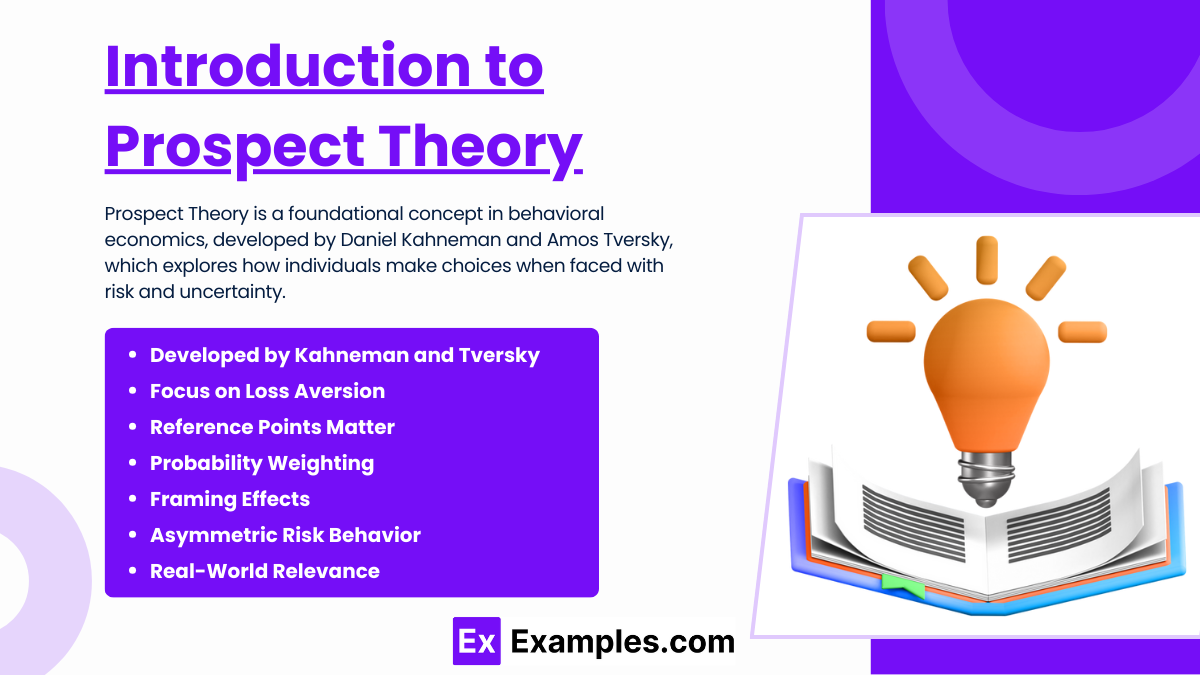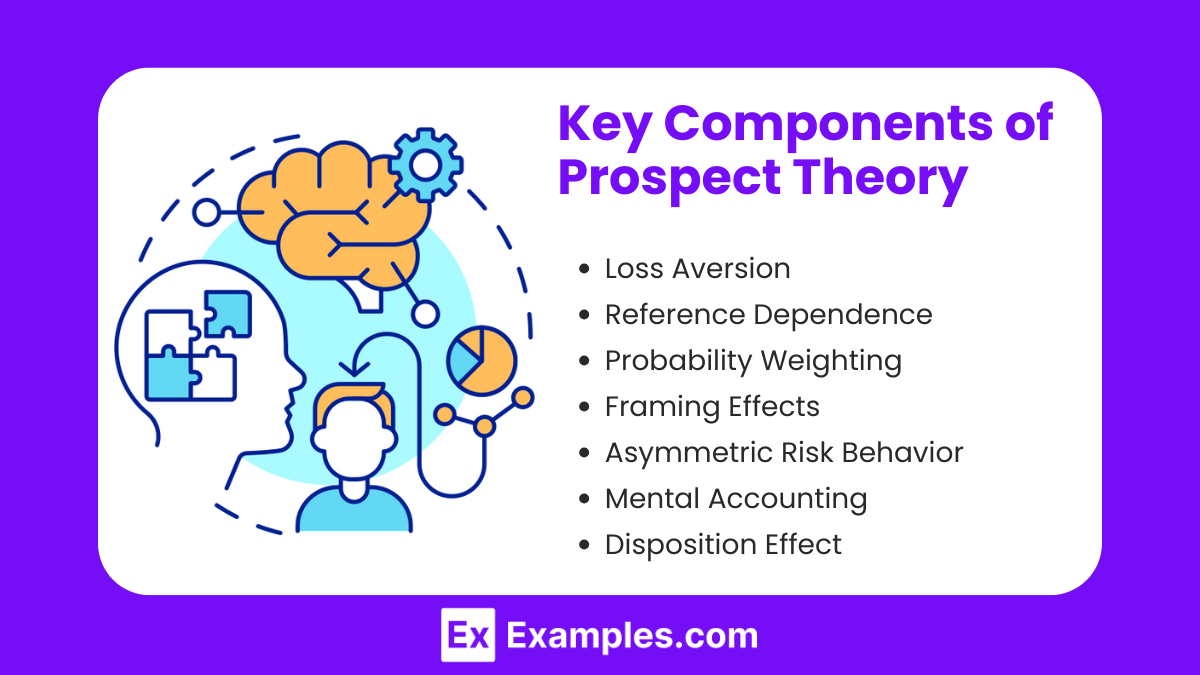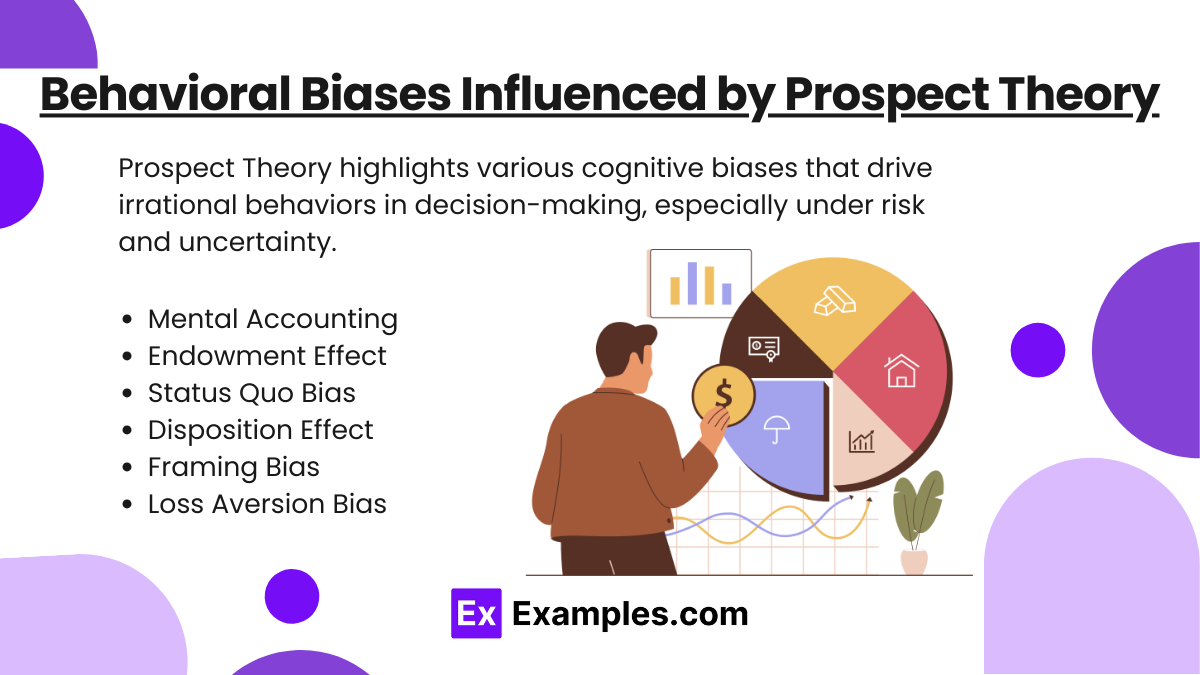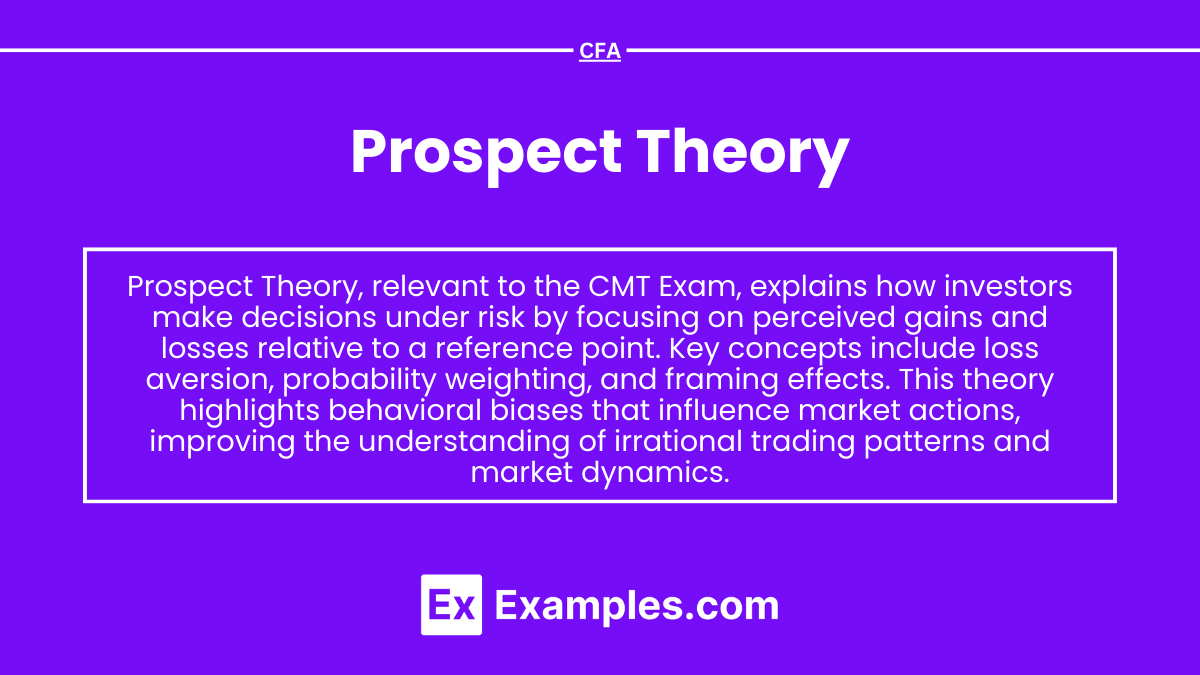Prospect Theory is a cornerstone of behavioral finance, essential for understanding decision-making under risk and uncertainty. It explores how investors perceive gains and losses, highlighting biases like loss aversion and framing effects. Mastering this theory is crucial for Chartered Market Technicians, offering insights into market behavior and improving trading strategies for optimal performance.
Learning Objective
In studying “Prospect Theory” for the CMT Exam within “Section III: Topics in Behavioral Finance,” you should learn to understand how individuals evaluate potential losses and gains under risk, differing from traditional economic models. Examine key components such as loss aversion, reference dependence, and the asymmetry in risk behavior for gains versus losses. Evaluate how psychological biases impact investor behavior and market dynamics, including framing effects and mental accounting. Apply this understanding to analyze real-world market scenarios, identifying behavioral drivers behind investment decisions. Utilize insights into market sentiment and investor psychology to enhance trading strategies in “CMT Level 2” analysis.
Introduction to Prospect Theory

Prospect Theory is a foundational concept in behavioral economics, developed by Daniel Kahneman and Amos Tversky, which explores how individuals make choices when faced with risk and uncertainty. Unlike traditional theories that assume rational decision-making, Prospect Theory accounts for the biases, emotions, and psychological influences that drive human behavior. This theory is particularly relevant in finance and investing, as it sheds light on why investors often make seemingly irrational choices.
1. Developed by Kahneman and Tversky
In 1979, Daniel Kahneman and Amos Tversky introduced Prospect Theory as a response to the limitations of Expected Utility Theory, which assumed that individuals make rational, utility-maximizing decisions under conditions of risk. Kahneman and Tversky argued that people often behave irrationally due to cognitive biases and emotions, leading them to make decisions that deviate from expected outcomes. This groundbreaking work earned Kahneman the Nobel Prize in Economic Sciences in 2002 (Tversky had passed away and was not eligible).
2. Focus on Loss Aversion
Loss aversion is one of the central concepts of Prospect Theory. It suggests that people feel the psychological impact of losses more intensely than equivalent gains. For example, the pain of losing $100 is often perceived as greater than the joy of gaining $100. This aversion to losses can lead to conservative behavior, as individuals are more likely to avoid risks when potential losses are at stake. This explains why many investors hold onto losing investments too long, fearing the realization of a loss.
3. Reference Points Matter
Prospect Theory posits that individuals make decisions based on perceived gains or losses relative to a reference point rather than absolute outcomes. A reference point could be an investor’s purchase price of a stock or a desired financial goal. This reference-dependence means that what one considers a gain or loss can vary significantly, even for the same outcome, based on their personal perspective or prior expectations.
4. Probability Weighting
Individuals often do not evaluate probabilities in a linear or accurate manner. Small probabilities, such as winning a lottery, tend to be overestimated, while high probabilities are often underestimated. This tendency to misinterpret probabilities can lead to irrational behavior, such as excessive risk-taking in lottery-like scenarios or underestimating near-certain outcomes. This insight is crucial for understanding behaviors like gambling and speculative trading.
5. Framing Effects
Framing describes how the presentation of choices or outcomes can influence decision-making. People may react differently to the same outcome based on whether it is presented as a gain or a loss. For instance, a treatment with a “90% success rate” is more appealing than one described as having a “10% failure rate,” even though both statements convey the same information. In financial markets, framing can influence investment decisions, advertisements, and perceptions of risk.
6. Asymmetric Risk Behavior
Prospect Theory illustrates that individuals exhibit different risk behaviors depending on whether they are facing potential gains or losses. When presented with gains, people are typically risk-averse, preferring a certain outcome over a gamble with a higher expected value. Conversely, when confronted with potential losses, people often become risk-seeking, willing to take bigger risks to avoid a definite loss. This asymmetry leads to behaviors such as holding onto losing stocks in the hope of a turnaround.
7. Real-World Relevance
Prospect Theory has profound implications for understanding real-world market behaviors. It explains phenomena such as market overreactions, bubbles, and crashes driven by investors’ irrational fears and exuberance. Behavioral biases, like herd behavior and mental accounting, can be traced back to Prospect Theory’s tenets. This understanding helps market participants, financial advisors, and policymakers better predict, analyze, and mitigate irrational market movements and investor decisions.
Key Components of Prospect Theory

Prospect Theory delves into how individuals make decisions involving risk, emphasizing the cognitive biases that drive choices. This theory, formulated by Kahneman and Tversky, identifies specific elements that impact decision-making processes in ways traditional economic models often overlook. By understanding these key components, it becomes evident why people sometimes behave irrationally, especially when confronted with gains, losses, and uncertainty.
1. Loss Aversion
Loss aversion is a core aspect of Prospect Theory, suggesting that losses are felt more acutely than equivalent gains. In simple terms, the pain of losing $100 is often much greater than the joy of gaining $100. This emotional reaction makes people more cautious about losing what they have, often leading to risk-averse behavior in the face of potential losses. In investment contexts, this bias can result in holding onto losing investments, hoping to recover, rather than accepting a loss.
2. Reference Dependence
According to Prospect Theory, people make decisions based on changes from a reference point, not the absolute value of outcomes. This reference point could be the status quo, a target value, or a previous benchmark. As such, the perception of gains or losses depends on how the outcome compares to this reference point. For example, an investor’s satisfaction with a 10% return may differ based on whether they expected 5% or 15%. Reference dependence underscores the relativity of decision-making.
3. Probability Weighting
Prospect Theory demonstrates that individuals do not perceive probabilities in a straightforward, linear way. Small probabilities are often overweighted, meaning unlikely events (such as winning a lottery) are perceived as more likely than they actually are. Conversely, highly probable outcomes may be underestimated. This cognitive distortion affects risk assessment and explains why people sometimes take irrational risks, such as gambling heavily on low-probability outcomes.
4. Framing Effects
Framing effects highlight how the context or wording of a choice influences decision-making. Even when two choices offer the same outcome, individuals may choose differently depending on how the options are presented. For instance, a “95% chance of success” is often perceived more positively than a “5% chance of failure.” This effect shows that people’s risk preferences can be manipulated simply by changing the way choices are described, and it has profound implications for marketing and investment communication.
5. Asymmetric Risk Behavior
People exhibit different risk-taking behaviors when faced with gains versus losses. Prospect Theory reveals that individuals are generally risk-averse when it comes to gains, preferring a guaranteed outcome over a gamble with a potentially higher expected value. Conversely, they become risk-seeking when facing losses, willing to take greater risks to avoid a definite loss. This asymmetry helps explain market behaviors like panic selling during downturns or speculative bubbles driven by a reluctance to miss out on potential gains.
6. Mental Accounting
Mental accounting refers to the tendency for individuals to separate money into different mental “accounts” based on subjective criteria, like the source of the money or its intended use. This can lead to irrational financial behaviors, such as treating a tax refund differently from regular income. In investment terms, this bias may cause people to make inconsistent decisions about their portfolio, such as overvaluing short-term gains or maintaining separate accounts for “safe” and “risky” assets.
7. Disposition Effect
The disposition effect describes the tendency for investors to sell winning assets too quickly to “lock in gains” while holding on to losing assets too long in the hope of a turnaround. This behavior stems from a desire to avoid realizing losses, which feels more painful than missing out on potential future gains. Prospect Theory’s insights into loss aversion and risk-seeking behavior in the face of losses explain why many investors struggle to cut their losses, even when rational analysis suggests otherwise.
Behavioral Biases Influenced by Prospect Theory

Prospect Theory highlights various cognitive biases that drive irrational behaviors in decision-making, especially under risk and uncertainty. By understanding these biases, investors and market participants can gain insights into why they, or others, might deviate from rational financial choices. These biases influence behaviors such as risk-taking, investment decisions, and responses to market volatility, offering a clearer view of market anomalies and inefficiencies.
1. Mental Accounting
This bias refers to the human tendency to categorize money into different “accounts” based on subjective criteria, such as the source or intended use of funds. People may treat a bonus differently from regular salary, even though both are equivalent in value. This mental separation can lead to irrational decisions, such as splurging “windfall” gains while being conservative with regular income. In investing, it often leads to inconsistent strategies, like allocating risk differently between savings and speculative investments.
2. Endowment Effect
The endowment effect causes people to overvalue assets simply because they own them. For example, a person may place a higher value on a stock they hold compared to one they are considering purchasing. This bias leads to an irrational attachment to possessions, making it difficult to sell or trade assets even when it’s financially beneficial. In markets, it explains why investors hold on to assets they should sell, as they view the cost of losing what they “own” as greater than potential gains.
3. Status Quo Bias
This bias reflects a preference for the current state of affairs, resisting change even when beneficial options are available. Many investors prefer to stick with existing strategies or holdings, avoiding new investments or innovations due to fear of change. This behavior can lead to missed opportunities and inertia in portfolio management, resulting in suboptimal performance over time. The status quo bias is closely related to loss aversion, as change is often perceived as introducing risk or potential loss.
4. Disposition Effect
The disposition effect describes the tendency of investors to sell assets that have appreciated in value too quickly, locking in gains, while holding onto losing assets too long in hopes of recovering losses. This behavior stems from loss aversion and risk-seeking tendencies in the face of losses, as explained by Prospect Theory. Rather than cutting losses and moving to more promising investments, investors often cling to underperforming assets, hoping for a rebound.
5. Framing Bias
Framing bias occurs when individuals make different decisions based on how information is presented, rather than the actual content. For instance, an investment option described as having a “90% chance of success” may be preferred over one described as having a “10% chance of failure,” even though both convey the same probability. This bias can lead investors to interpret market data, news, and investment opportunities differently, depending on the language used, ultimately influencing their decisions and risk perceptions.
6. Loss Aversion Bias
Loss aversion bias, a central concept in Prospect Theory, causes individuals to fear losses more than they appreciate equivalent gains. This leads to conservative decision-making and a reluctance to part with underperforming investments. In markets, it explains behaviors like reluctance to sell stocks at a loss or overreacting to market downturns. By focusing disproportionately on avoiding losses, investors may miss opportunities for growth or act irrationally in response to negative news.
Applications in Market Analysis and Trading Strategies

Prospect Theory offers valuable insights into market behaviors and investor psychology, directly impacting trading strategies and market analysis. By understanding the biases and decision-making tendencies highlighted by the theory, traders and financial professionals can better anticipate market movements, design effective strategies, and mitigate irrational behaviors. Below are key applications of Prospect Theory in market analysis and trading.
1. Identifying Investor Sentiment
Prospect Theory helps explain fluctuations in market sentiment driven by fear and greed. By recognizing that investors are often loss-averse and risk-seeking in the face of losses, market analysts can predict patterns of panic selling during downturns or irrational buying during speculative bubbles. This understanding allows traders to position themselves accordingly, either capitalizing on market inefficiencies or hedging against volatility.
2. Developing Behavioral Trading Strategies
Behavioral finance strategies leverage the insights from Prospect Theory to exploit predictable market behaviors. For example, “contrarian investing” involves going against market trends by buying assets when others are selling due to panic, and vice versa. Similarly, strategies like momentum trading rely on the tendency of investors to follow trends and overreact to gains and losses. Recognizing behavioral biases allows for strategies tailored to market sentiment shifts.
3. Risk Management Adjustments
Understanding that investors exhibit asymmetric risk behavior when facing gains and losses helps professionals design better risk management strategies. By accounting for clients’ loss aversion, financial advisors can structure portfolios to minimize emotional reactions to market downturns. This may involve employing hedging techniques, diversifying assets, or setting more conservative stop-loss orders to mitigate irrational decision-making.
4. Predicting Market Anomalies
Prospect Theory can explain market anomalies, such as excessive volatility, speculative bubbles, and asset mispricings. Behavioral biases, like the disposition effect, lead to market behaviors where overvalued assets continue to rise due to reluctance to sell, while undervalued assets may languish due to investors’ attachment to their losses. Understanding these phenomena helps market participants predict and potentially profit from mispricings.
5. Improving Communication and Investor Education
Investment communication strategies can be optimized using insights from Prospect Theory. For instance, framing investment options in terms of “avoiding losses” rather than “potential gains” may resonate more strongly with loss-averse clients. By recognizing how framing, mental accounting, and reference points affect decisions, advisors can craft more effective communication strategies to guide investor behavior and expectations.
6. Behavioral Portfolio Construction
Portfolios can be constructed or adjusted with an understanding of investors’ biases and risk preferences. By accounting for mental accounting and loss aversion, asset allocation strategies can be tailored to match an investor’s psychological comfort zone, helping reduce anxiety and improve adherence to long-term investment plans. Behavioral insights can lead to the creation of “core and satellite” strategies or other diversified approaches that align with individual preferences.
7. Case Studies and Real-World Examples
Real-world market phenomena, such as the dot-com bubble or the 2008 financial crisis, provide practical examples of Prospect Theory in action. Analyzing these events through the lens of behavioral biases—like overconfidence, herding, and loss aversion—enables better understanding of how irrational behaviors shape market trends. Learning from these historical examples allows traders and analysts to refine strategies for responding to future crises or booms.
Examples
Example 1: Investor Behavior During Market Crashes
During major downturns, such as the 2008 financial crisis, investors often displayed behaviors explained by Prospect Theory. Loss aversion led many to sell off their holdings at a loss due to fear of further market declines, exacerbating panic selling and volatility. Conversely, some investors exhibited risk-seeking behavior by doubling down on risky investments in hopes of recouping losses.
Example 2: Lottery Participation and Probability Misjudgment
People frequently buy lottery tickets despite very low odds of winning, as Prospect Theory shows that individuals tend to overweight small probabilities. The allure of a large jackpot and the perception of a slight chance of winning cause people to engage in what, by rational standards, is a poor financial decision.
Example 3: Endowment Effect in Real Estate
Homeowners often place a higher value on their property simply because they own it. This bias, known as the endowment effect, can lead to unrealistic pricing expectations when selling, making it difficult to accept offers that align with the market value but fall short of their perceived worth.
Example 4: Framing of Investment Outcomes
The way investment choices are framed influences investor decisions. For instance, an investment described as having a “95% chance of success” may be preferred over one described as having a “5% chance of failure,” even though the probabilities are identical. This framing effect, highlighted in Prospect Theory, impacts risk perception and decision-making.
Example 5: Disposition Effect in Stock Trading
The disposition effect is a behavior where investors sell assets that have appreciated quickly, “locking in gains,” while holding onto losing assets longer, hoping they recover. This behavior is rooted in loss aversion, as investors are more averse to realizing losses than they are eager to realize equivalent gains, often resulting in suboptimal portfolio performance.
Practice Questions
Question 1:
Which of the following best describes loss aversion according to Prospect Theory?
A. Individuals value gains more than equivalent losses.
B. Individuals prefer to avoid losses rather than acquiring equivalent gains.
C. Investors focus on long-term gains and ignore short-term losses.
D. Probability weighting is the main reason for loss aversion.
Answer: B) Individuals prefer to avoid losses rather than acquiring equivalent gains.
Explanation:
Loss aversion is a key concept in Prospect Theory, which suggests that people feel the pain of losses more strongly than the pleasure of equivalent gains. This can lead to risk-averse behaviors, especially when there is a chance of incurring a loss. Option B accurately describes this principle, while the other options either misrepresent or fail to fully capture the essence of loss aversion.
Question 2:
Which cognitive bias is most closely associated with an individual placing a higher value on assets they own compared to those they do not own?
A. Framing Effect
B. Disposition Effect
C. Endowment Effect
D. Status Quo Bias
Answer: C) Endowment Effect
Explanation:
The endowment effect occurs when individuals overvalue something simply because they own it, leading to attachment and resistance to sell it at market value. This bias causes a discrepancy between perceived and actual value. None of the other options capture this unique owner-based overvaluation.
Question 3:
How does Prospect Theory explain the tendency of people to purchase lottery tickets despite very low odds of winning?
A. Probability weighting leads people to underestimate the likelihood of winning.
B. People overestimate small probabilities, making rare events seem more likely than they are.
C. Loss aversion drives individuals to avoid investing in lotteries.
D. The disposition effect encourages high-risk behaviors.
Answer: B) People overestimate small probabilities, making rare events seem more likely than they are.
Explanation:
According to Prospect Theory, individuals often overweight small probabilities, which makes rare events, such as winning a lottery, appear more likely than they actually are. This leads people to engage in behavior that might seem irrational, such as purchasing lottery tickets. Option B correctly reflects this concept, while the other options misinterpret or do not apply directly to this behavior.


